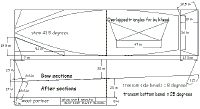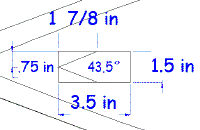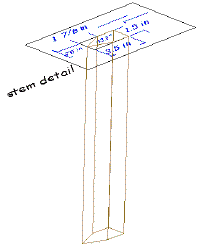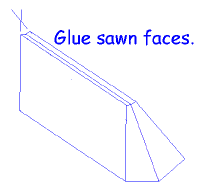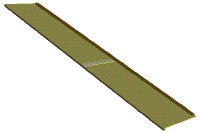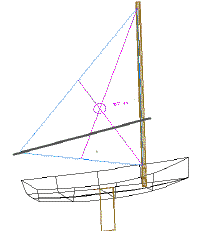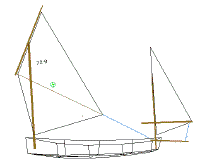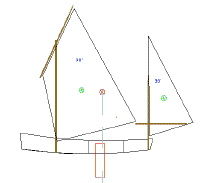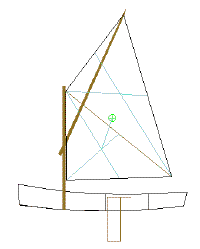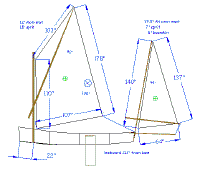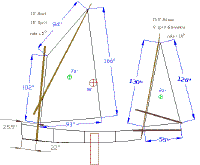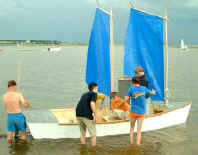
|
Daydream (A song I wrote about this boat.)
|
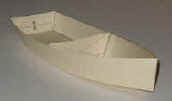 |
The ultimate goal was to build her in a day. (See Easy does it?)
This design evolved from the "Least Cuts Boat" or LCB.
Inspired by Lew Clayman on the boat design list. (updated June 19, 2002)
See photos of Brian Schmittling's Daydream being built in Mississippi.
And photos of my build of the prototype - in progress...
So I decided to try to upscale my Summer Breeze to a 4 sheet boat and see what it might take to build her with the fewest saw cuts. At first I used overlapping plywood to the extreme to get the fewest cuts, but the reality is it's easier to just make a couple of more cuts. But this thought experiment was fruitful. I strayed from Summer Breeze and ended up with a more plumb bow sharpie design with both the sheer and the chine being cut as straight lines. With the use of some simplified build techniques I think she could be built in a day. I'm getting very excited about this design. I intend to build the prototype soon and will document how she does.
This could be made with 4 sheets of 1/4" like Featherwind. Might make the bottom and transom out of 3/8". Or maybe 2 sheets of 3/8" for the sides, and 2 sheets of 1/2" for the bottom & transom would make it stouter and require less framing. The added weight means more stability and more robust, but also a lot more to muscle around. Depends on whether you intend to trailer her, or car top her. A heavier boat is less reactive to the shifting weight of the crew. I intend to build the prototype of 1/4" BC pine ply.
| I didn't end up using the overlapping triangle approach of
my original design. I bent the sides around the middle frame then added
frame 1 and 3. I used 1x3s and ply gussets. They fall 57", 104",
and 151.5" from the bow -
measured along center line. (I'll try to get the measurements for marking the sides while flat, but for now all I have are the center line positions.) |
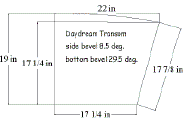 |
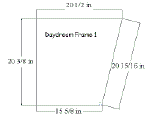 |
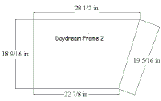 |
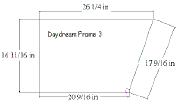 |
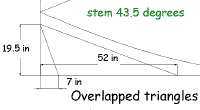 |
The center bulkhead gets made in two parts from the bow bottom sheet. You'd mark the 19.5" dimension and the 52" dimension and cut them both. Stack them and cut from the 7" mark to the corner. |
| Greg Carlson's Hull program shows the ideal bulkhead placement is 96.5 inches from the bow. In my paper models I've found it also works where the ply joins. The test build will tell for sure. |
Inwales and spacers could also be of 1x2 and they might stiffen it enough to not need more than one bulkhead, particularly if we put in seat risers and screw in seats.
The keel can be 16 foot 1x2 with a laminated 1/2" skeg coming from the 8"x96" trim of the side sections. 8 foot 1x2 skid rails on either side of the keel would protect and stiffen the bottom. Two or three foot brace strips running across the bottom (athwartships) where the rower's feet fall would both facilitate rowing and further stiffen the bottom. The skeg can be omitted if your primary desire use is as a sailboat. She'll turn on a dime sailing, but will track less surely while rowing.
Laminations and scarfing (like the sides, bottom, skeg and the bulkhead) could be done with #14 3/4" bronze nails driven into cardboard first, then clinched against a bucking iron. This would eliminate any wait for glue to dry.
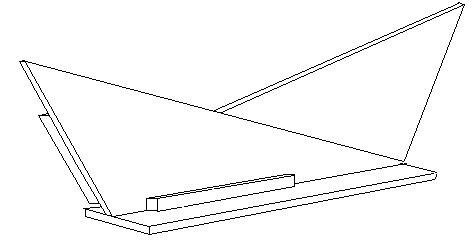 |
Another approach that I'm leaning towards is using 1x4 stock
as the butt blocks. One advantage is that no clinching is required.
7/8" bronze nails would work well. This could be the base of the mid
frame as well, and 3/4" square cleats could be PL glued to anchor the
ply of the frame. Here's a rough sketch. Not to scale of course, and only
2 cleats are shown for clarity. Use 3/4" spacers to align the frame
to the sides. Bottom can be scarffed off the boat later.
Note: 12.5" aft of side butt joint. |
| These two to the right are my latest model. The ones below are the first one, with a more plumb bow. | 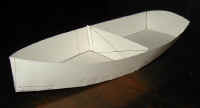 |
 |
 |
 |
 |
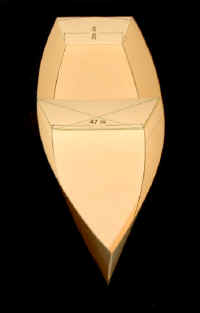 |
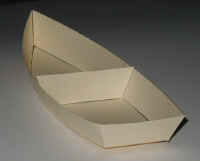 |
 |
Doing the sailing rig very basic is an interesting challenge as well. I'm thinking a 2x4 mast a la Dave Carnel.
Materials would be something like:
Mast: 12 to 16 foot 2x4 (tapers to 1.5" sq at top)
Spars: 12 ft 2x4 (ripped in two taperd at ends) for yard and sprit -
Boards: 1/4 sheet (2'x4') 1/2" ply for rudder & leeboard -
Tiller - 8 ft 1x2 .
Sail: 12'x15' poly tarp (ideally white)
Mast partner: either have one of the 1x10 seats double as a mast partner or use the 8" ply strip to laminate one.
Misc: 50ft of 1/4" line.. 2' section of 3" pvc for mast base - double stick fiberglass carpet tape -
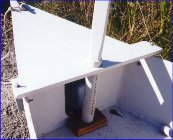 |
Here's is a way of using a 2x4 mast fitted into a PVC base so it can still rotate - very useful with a sprit sail rig. This idea borrowed from Don Hodges' 12 foot Skiff. That removable bolt on mast partner isn't a bad idea either. |
A removable center seat which doubles as a leeboard.
Maybe the simplest approach to a quick sail rig is demonstrated by Fritz Funk He folds over and trims a polytarp and secures it all with duct tape.
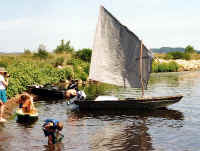 http://www.alaska.net/~fritzf/Boats/sailflat/jonsail.htm
http://www.alaska.net/~fritzf/Boats/sailflat/jonsail.htm
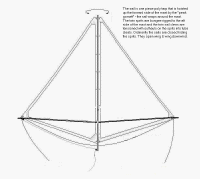 |
This slightly modified sketch I borrowed from Dave's
Polytarp Sail site.
Here's a slightly over the edge, but still doable in a simple way, sail idea. Fold over, round the mast poly tarp sail, with twin sprits bungee rigged to the aft side of the mast. Hidden inside the sail normally, exposed when running wing & wing. The easiest double sprit rigging I've come up with for this is holes in the ends of 1x2 sprits, on either side of a fair lead on the aft of the mast. A largish bungee cord runs through them and around the mast, knotted on top of the fair lead. By the way, Dave who I mentioned above has a 16' sharpie called Foolhardy he has a triangular "leg of mutton" sprit sail on. Nice looking boat - check her out. |
Back to Simplicityboats HomeMaterials:
4 sheets of 1/4" plywood.
13 - 16' 1x2s (or all the 1x2s could be ripped from one 16' 2x12, or 2 16' 2x6s - sometimes the clearest logs are saved for the largest boards so you might find a nice knot free one.)
The 1x2s are for rails, chines, seat risers, inwales and inwale spacers, frames, keel and bottom skid rails & foot braces
1 - 8' 1x4 for butt blocks for bottom and sides - also rip 3/4" square cleats for frame glue blocks
1 - 10' 1x4 for transom frame
1 - 3' 2x4 for the stem
1 - 3' x 1" hardwood dowel for corner braces - (replaces breast hook and quarter knees.)
1 - 10' 1x10 for seats
Glue: PL Premium glue & Tightbond II for "dry sailed" boats or above the water line. (If your boat doesn't live in the water) Epoxy for boats that will live in the water.
Jim Michalak has written up a great test on boiling plywood and glue samples...here.Bronze ring nails 3/4", 7/8" & 1"
Gallon of exterior latex house paint and a quart of trim for rails and accents.
Tools:
Circular saw, hand saw
Hammer
Drill
Plane
Sander
